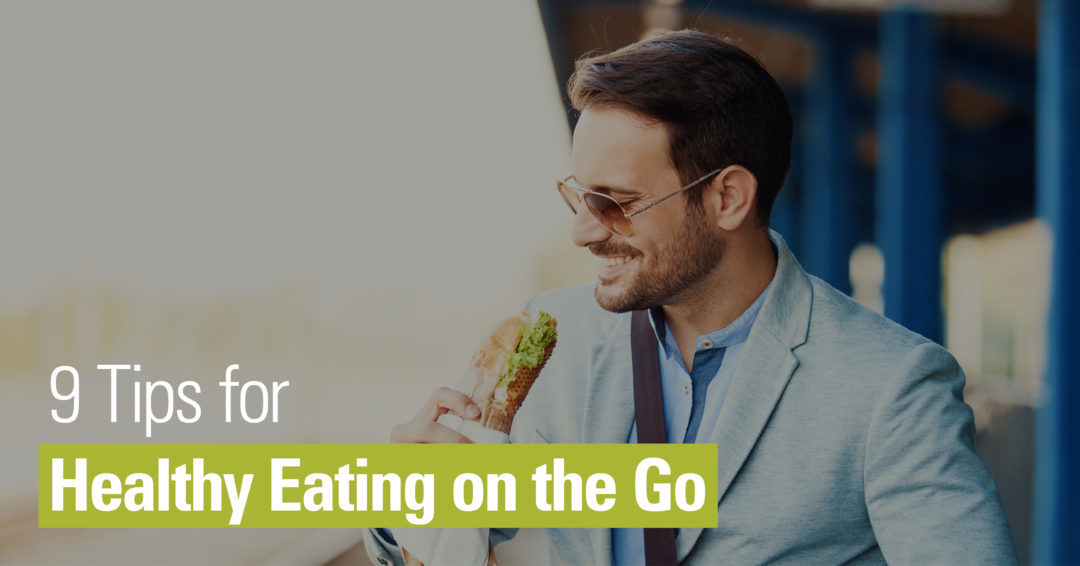Busy lifestyles can make it difficult to find time to plan and prepare meals that not only taste good but also nourish your body. It’s important to fuel your body with nourishing food to keep up with the pace of today’s lifestyle. Try these tips to help you eat healthy on the go.
- Make a plan. Look at your schedule for the coming week, and decide in advance what you’ll eat each day. Write it down or add it to your calendar, and make a shopping list.
- Prep on the weekends. Use your weekends to grocery shop, chop, prep, and cook your food for the week. Portion food into single-serve containers, and freeze anything that can’t be in the fridge longer than three days.
- Pack your lunch. If you cook ahead and in bulk, packing your lunch can be very easy and satisfying. You’ll also save money while eating healthier. Salads, soups, wraps, and sandwiches are also quick to put together.
- Upgrade or embrace your slow cooker. A slow cooker is a great option for busy people—put all the ingredients in, and forget about it. Meats, soups, rice, oatmeal—it’s a useful tool, and coming home to the scent of a hot, ready to eat meal is a wonderful feeling.
- Keep an emergency stash. If you get so busy that you skip breakfast or don’t bring lunch, it helps to have healthy food options stashed at your workplace. Stock up on instant, unsweetened oatmeal packets, individual servings of cranberries or raisins, dry-roasted or raw nuts, ultra-pasteurized milk (which doesn’t need refrigerated until opening), nut butters (such as almond, cashew, or peanut), whole grain crackers, and tuna packs.
- Know what your body needs. Assuming you eat three meals a day, then an average meal for a woman should have about 400-500 calories, 25-30 grams of protein, no more than 20 grams of fat, and less than 600 milligrams of sodium. For a man, an average meal should have 500-600 calories, 30-35 grams of protein, no more than 25 grams of fat, and less than 600 milligrams of sodium.
- Research restaurant foods. Research foods for your favorite restaurants so you know if the nutrients fall within the parameters of what an average meal should have. You may find that some restaurants simply don’t offer what you need.
- Prepare more and dine out less. This might take some getting used to, but once you get the hang of it, you’ll save time and money!
- Learn what a balanced meal is. A balanced meal includes protein, carbohydrate, vegetables, and healthy fat. Learn more about a balanced meal at ChooseMyPlate.gov. Here are a few examples:
- Protein
- 3 ounces canned tuna in water
- 3 ounces pre-cooked chicken breast
- 1 hardboiled egg with 2 hardboiled egg whites
- 3 ounces tempeh
- 3 ounces tofu
- Healthy carbs
- 1-2 slices whole grain bread
- ½ cup cooked whole grains like brown rice, quinoa, wild rice, or oats
- ½ baked potato with skin
- Fruit (considered a healthy carb)
- ½ banana
- 1 orange
- 17 small grapes
- Veggies (non-starchy; one serving = ½ cup cooked or 1 cup raw)
- Broccoli
- Carrots
- Leafy greens (spinach, Swiss chard, beet greens, romaine, etc.)
- Healthy fats
- 1 ounce or 2 tablespoons avocado
- 6 almonds
- 1 teaspoon oil (olive, canola, peanut, avocado, walnut, etc.)
- Protein
[thrive_leads id=’406′]

